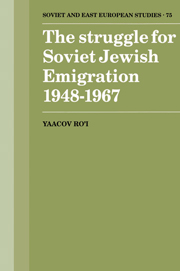Book contents
- Frontmatter
- Contents
- Preface
- Acknowledgments
- Glossary
- List of abbreviations
- Introduction
- PART I
- PART II
- 4 The outside world becomes aware of the problem
- 5 The campaign in the West gathers momentum
- 6 The outside world takes up the issue: 1963–1967
- PART III
- Conclusion
- Notes
- Bibliography
- Index
- Soviet and East European Studies
4 - The outside world becomes aware of the problem
Published online by Cambridge University Press: 31 October 2009
- Frontmatter
- Contents
- Preface
- Acknowledgments
- Glossary
- List of abbreviations
- Introduction
- PART I
- PART II
- 4 The outside world becomes aware of the problem
- 5 The campaign in the West gathers momentum
- 6 The outside world takes up the issue: 1963–1967
- PART III
- Conclusion
- Notes
- Bibliography
- Index
- Soviet and East European Studies
Summary
Early rumblings
The question of Soviet Jewish emigration appears to have aroused little interest outside the USSR in the late 1940s. This may have been due to the belief that the Jews identified so strongly with the construction of Soviet society that there was no interest on their part. Or it might be attributable to the Soviet Jewish community's having been cut off from the Jewish world for so long that Western Jews simply did not think very much about their lot. Instead, those who were concerned with aiding Jews concentrated on the Displaced Persons, the Jews of Eastern Europe and those of the Arab countries, whose desperate position was much better known. For Israel it would have been senseless to raise this sensitive issue with Moscow at a time when the Soviet interest was in aiding it to establish and maintain a viable Jewish state in Palestine. This caution on the part of the Israeli leadership, which led it to refrain from any open act of identification with Soviet Jewry, also led the Jewish state to adopt a policy of studied non-alignment between East and West on the grounds that there were large Jewish communities in both camps. It also made the rumors that Mrs. Meyerson had made representations to the Soviet government on behalf of Prisoners of Zion and other Jews who wished to join their relatives in Israel and thus wrought havoc on the Soviet Jewish community all the more poignant.
- Type
- Chapter
- Information
- The Struggle for Soviet Jewish Emigration, 1948–1967 , pp. 89 - 120Publisher: Cambridge University PressPrint publication year: 1991



